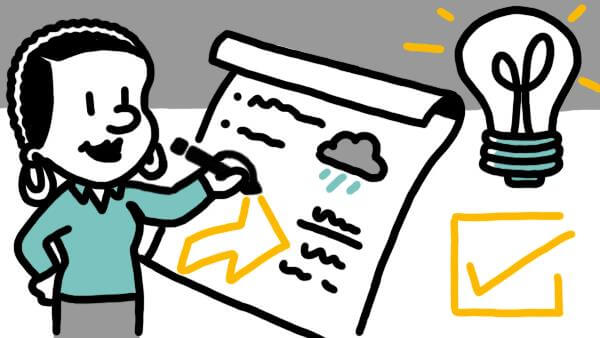It’s difficult to simply memorize a lesson, a presentation, or a chapter of a textbook without some assistance. Even if the information is engaging, when it comes time to take an exam, write a report, or explain the ideas to someone else, almost all of us need something to ensure we’ve retained the information, and are ready to act upon it.
Fortunately, both the academic and business worlds encourage a great way to augment retention: note-taking.
Let’s examine some reasons why note-taking matters, and how you can practice better note-taking in your day-to-day duties.
Why Note-Taking Matters
Looking first the “why” of note-taking, Jennifer Gonzalez points to several studies that conclude that students learn better when taking notes than when they are not. “The thinking behind this is that note-taking requires effort,” Gonzalez says of the findings. In other words, note-taking is an active engagement with the information, rather than passive reception of it.
Gonzalez further explains that “…the act of encoding the information into words or pictures forms new pathways in the brain, which stores it more firmly in long-term memory.” It also allows easier revisiting of the material, which can again help secure the learner’s retention.
The use of the word ‘pictures’ is no accident, either: “Compared with writing alone, adding drawings to notes to represent concepts, terms, and relationships has a significant effect on memory and learning,” the author adds in a later point. Visuals are a major boost to note-taking’s effectiveness, and Gonzalez isn’t the only one to acknowledge that.
Note-Taking Tip: Keep it Simple
The techniques promoted to improve note-taking before the TOEFL (Test of English as a Foreign Language) include a variety of points. Keep it simple, and “focus on capturing just the main points;” keep moving, acknowledging that instructors and trainers rarely slow down for note-takers; and use note-taking symbols.
This argument for using symbols—essentially, the use of shorthand—is a sort of visual/textual hybrid form of note-taking. It uses small and easily-drawn visuals to take the place of full words. And it captures more information in a shorter amount of time. It’s a great way to “keep moving” and take more notes faster, as well as increase retention.
Note-Taking Tip: Incorporate Visuals
But what of a fuller, more thorough use of visuals in note-taking? How effective is this approach in your efforts to improve retention of information?
Overall, we know it improves the student’s retention, recall, and understanding of information. More than that, it engages all types of learners “as [they] connect information obtained through all the sensory systems.”
Visual note-taking provides an advantage to learners who might not find text-only note-taking easy or helpful. By engaging the visual portion of their brain, they create the same heightened retention and understanding that more verbal learners acquire through non-visual notes.
Encouraging this approach is equally valid. Whether in a classroom or during a keynote speaker’s address, is an inclusive and open-minded way to promote retention.
Visual note-taking facilitates also forms a link between “new knowledge [and] existing knowledge” from which learners can benefit. By creating a familiar visual to capture a new idea, such as a fractured shield to represent the ozone layer, the note-taker is taking advantage of the mind’s associative power.
The next time the ozone layer comes up, the learner will likely remember that broken shield. They will have a much better likelihood of remembering the ozone layer’s definition and current state.
Note-Taking Tip: Write & Draw to Become a Better Listener
Visual note-taking can also make you a better listener. “Take time to listen before writing. You don’t have to be drawing or writing the entire time.” This a sort of inversion of the logic behind shorthand—which hopes to capture more information, faster.
For learners who don’t write or draw as quickly, the answer might be to draw nothing for a moment. Simply listen before beginning to draw. Even if your speed of drawing isn’t a problem, taking time before drawing lets you parse the truly salient points from a discussion—instead of desperately filling the page with symbols that attempt to capture each and every word.
Two or three vital images from ten sentences might be far more useful to your retention and comprehension than a (likely incomplete) attempt to capture every word. Not all examples of a concept are crucial to understanding it; take a moment and draw the example that truly resonates with you.
Key Takeaways
Fundamentally, note-taking increases one’s ability to retain information by making an active participant out of the listener. Whether that’s through text or visuals, as research above shows, that active role forms different and new pathways in the mind.
Those pathways inevitably lead to easier recall and understanding. And when you encourage visual note-taking, you include more learners, engage more senses, and allow for novel workarounds for traditional text-based note-taking.
This is part of why many graphic recording sessions, in which an artist draws in concert with a speaker at an event, often involve participatory elements: heightened sensory engagement, active involvement with the material, and close listening are all afforded to those who draw along with the speaker.
What techniques do you use in note-taking? Do you utilize visuals when you take notes? Would you encourage others to try it, and if so, would you trend towards shorthand or larger, associative visuals? How might your company encourage note-taking at its next event?

